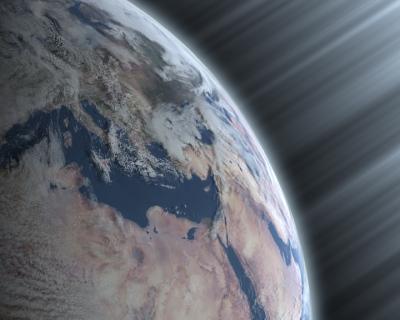New work out of the Danish National Space Center (DNSC) suggests a startling connection between star-making in the Milky Way and the evolution of life on Earth. During a period of intense star-creation that began some 2.4 billion years ago, ocean-borne bacteria went through cycles of growth and decline of an intensity never since equalled. The Danish study links this variability with incoming cosmic rays that reach Earth from exploded stars. The star-making period in question was a time of numerous supernova explosions.
To reach these conclusions, the Space Center’s Henrik Svensmark studied the record of heavy carbon in sedimentary rocks. Growing bacteria and algae in ocean waters absorb carbon-12, leaving carbon-13 to enrich the sea; the latter begins to appear in the carbonate shells of sea creatures. By studying variations in carbon-13, Dr. Svensmark can see how much photosynthesis was going on when the shell-making species were alive.
And it turns out that the biggest fluctuations in productivity coincided with high star formation periods as well as cool periods in Earth’s climate. During a billion year period when star formation was slow, the Earth’s climate was warmer, cosmic rays were less intense, and productivity in the biosphere was all but unchanged. Says Svensmark: “The odds are 10,000 to 1 against this unexpected link between cosmic rays and the variable state of the biosphere being just a coincidence, and it offers a new perspective on the connection between the evolution of the Milky Way and the entire history of life over the last 4 billion years.”

Image: Cosmic radiation penetrating the atmosphere promotes the formation of clouds which have a cooling effect on Earth’s climate. Credit: Danish National Space Center.
How would cosmic rays affect biology on Earth? One possibility is a link between cosmic rays and cloud formation, the subject of recent experiments reported by the DNSC. Stronger winds during the cold periods caused by increased cloud cover would stir ocean waters and improve the supply of nutrients in surface water, creating greater fluctuations in biological activity. All this as the result of supernovae activity in nearby space.
The paper is Svensmark, “Imprint of Galactic dynamics on Earth’s climate,” Astronomische Nachrichten Vol. 327, Issue 9 (October 2006), pp. 866-870), with abstract here.


Paul,
Do you know where the evidence for intense periods of star formation comes from? How do we know the cyclicity of star formation periods, through statistical examinations of the ages of stars in clusters or something similar?
Good question, Anthony, and I hope to have an answer from Dr. Svensmark on this soon. If any readers have information on this, I hope they’ll jump in as well.
Combine this with what happens during galactic collisions, and you have the interesting possibility that complex biospheres could get kickstarted by such events…
Hi Andy
That’s how complex life was produced in abundance in our Galaxy and M31 in Doc Smith’s “Lensman” saga. Prior to the collison, in both Galaxies, only the Arisians existed – while the Eddorians intruded from wholly different Universe. I think this news would’ve made the old Doc smile.
Adam
As he has done before, Adam now gets me dusting off old copies of cherished books. We should talk about the Lensman stories in a longer post some time soon.
Shell producing creatures? I thought that multicellular life was only a half billion years old. Unless we’re talking about bacterial colonies that leave structures behind…